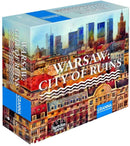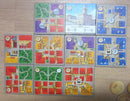Description
The game was $64.99
- Game in French
- Number of players: 2 - 4
- Duration: 45 - 60 min
- Suggested age: 10
Warsaw is a unique city. It is said that she "survived her own death", and there is truth in all this. The capital of Poland was largely destroyed during the Second World War, and its reconstruction was an exceptional urban development process. Warsaw is a combination of elegant Saxon-era buildings, interwar architecture, socialist blocks and modern buildings. Walking through the streets of Warsaw's Wola district, you can see this diversity at a glance. Modern glass office buildings rub shoulders with pre-war car garages, and concrete block buildings touch elegant old houses, which show signs of the decadence of time. Some see it as a spatial disorder, while others see it as the determination of the inhabitants. These two points of view are correct, because that is how Warsaw is. She may not be the most beautiful, but she is strong and determined. Nothing reflects the character of the city better than the diversity of its buildings.
In Warsaw: City of Ruins, players build Warsaw together over six eras, from the time Warsaw became the capital at the end of the 16th century to modern times. Each player creates their own district of the city. At the end of each of the six epochs, districts give income and victory points to their owners. After six rounds, the one with the most points wins.
Specifically, each epoch includes a phase of construction and a phase of income, with wars at the end of the third and fourth epochs. During the construction phase of an era, players mix the city tiles with the number of the current era, then distribute several tiles to each player. Each player chooses one of the tiles, then places it face down on the table. All players simultaneously reveal the tiles they have chosen, and each player chooses one of two possible actions:
Throw his tile in the box and take three pieces from the bank.
Pay the cost of the tile in pieces and build the tile in his neighborhood.
Instead of placing a tile on an empty square, a player can choose to build on an existing tile. Simply place the new tile directly on an existing tile, covering it entirely. Thus, the price of the new tile is reduced by the price of the old tile it covers. A player's area can never be larger than a rectangle of 3×4 or 4×3 tiles. Each city tile is divided into four neighborhoods, and each neighborhood has its own type of building, so a tile can have 1 to 4 different types of buildings. Public buildings and bollards are always separate individual areas, even if they are adjacent to each other. They also occupy an entire tile.
During the income phase, the terminals are placed and players receive coins and victory points.
Payment & Security
Your payment information is processed securely. We do not store credit card details nor have access to your credit card information.




